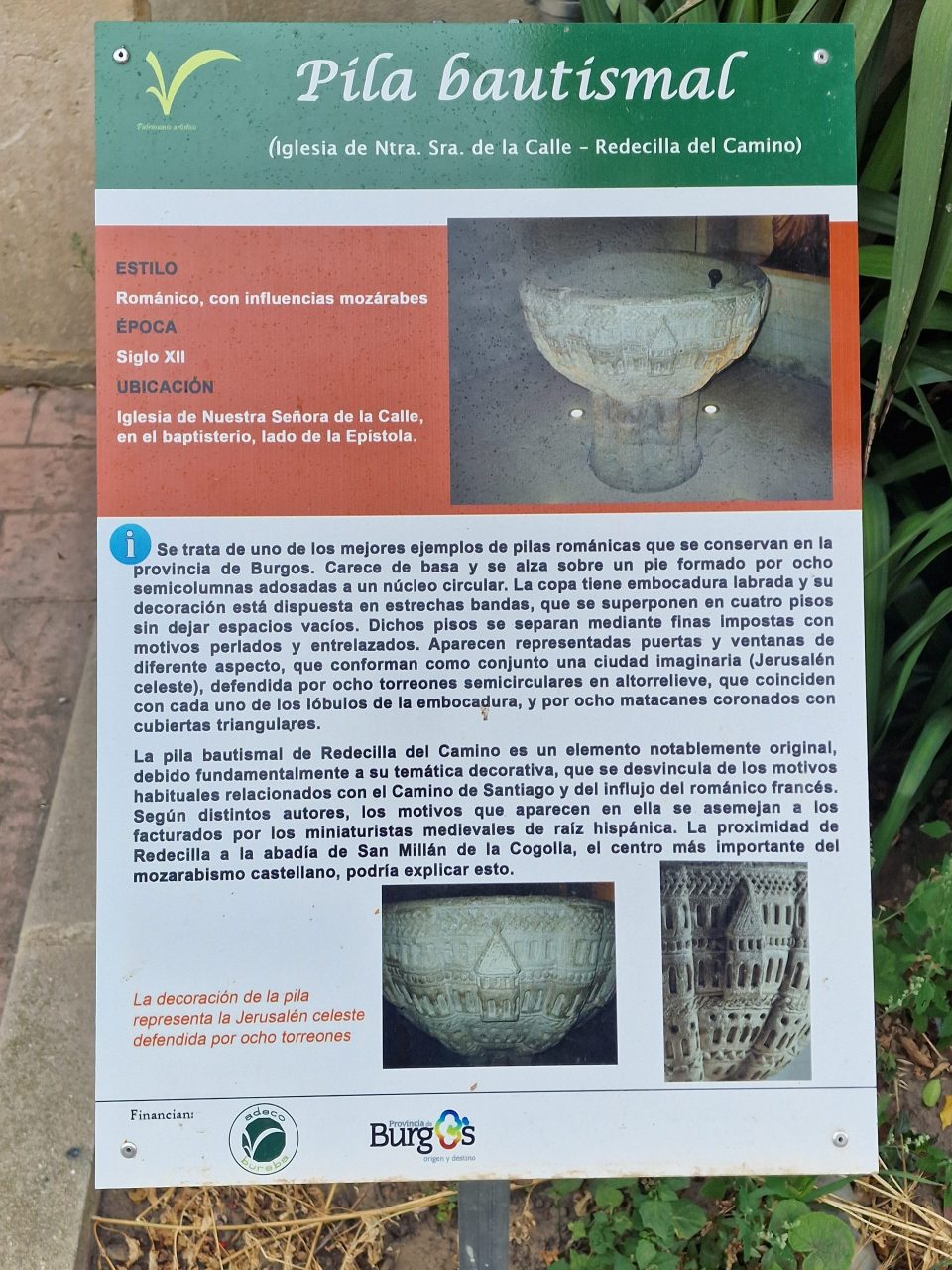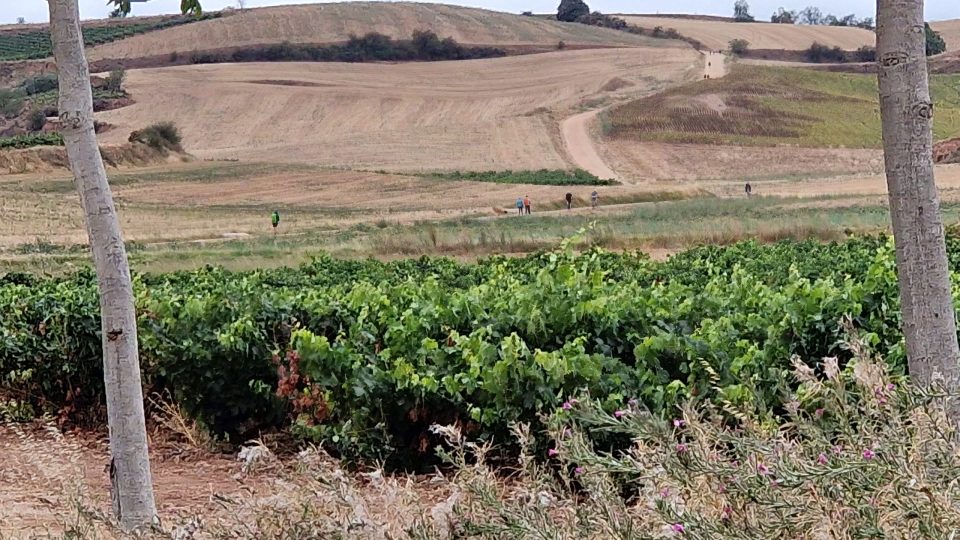Tuesday 29 August 2023 – The destination today was San Juan de Ortega, about 25km away, with an uphill section that looked non-trivial, though, of course, minor compared to the demands of Day 1.

The ascent would be one third that of day 1, but still 300 metres to be climbed within about 2 km. The forecast according to Accuweather was at least encouraging in that we wouldn’t have to do this in punishing heat – the predicted temperatures of the day varied from 13°C to 20°C. Chance of rain was medium.
The hotel served breakfast from 0700, and so we were there promptly, and eventually joined by some locals, including the police.

It was a rudimentary breakfast, frankly, but at least it included a cup of Twining’s finest Earl Grey.
We left at 0730, and were grateful for our rain jackets, not for dryness but for warmth. At least the wind wasn’t as strong or as cold as yesterday. On the way out, Belorado showed off some more of its murals, starting with intriguing instructions.

Doing that revealed this

and on the way out there were several more on display.
The threat of rain seemed a long way off and the early morning light gave us some nice views.



Before too long we had reached another village, Tosantos, and we were sufficiently chilled to call an early coffee break at a bar next to the rather pretty church.

En route there we met an Australian lady who professed to be practically unable to continue because she’d had nothing to eat so far that day. So we carefully helped her along to the cafe, and I hope it was the lack of blood sugar that made her a right moaning Minnie, because she did nothing but complain about anything and everything. Fortunately there were others at the cafe who she knew and on whom she inflicted herself, so we could make a break for it fairly quickly without seeming to be rude.
Our original plan had been to call in at the next village, Villambistia,

but we pressed on instead, to the final village before the climb, Villafranca Montes de Oca, where we stopped for a refuelling coffee and snack. En route we passed a great lump of something

that turned out to be all that remains of Ermita de San Felices; and a stream that was simply chocker with water cress,

not a sight that I expected to see in Spain, somehow. How parochial I am!
The coffee stop in Villafranca was strictly functional

and the way out led past an attractive church

on to the Steep Bit.

I reckon that’s somewhere around one in five; it may not look all that steep, but I was certainly glad to have my poles to help. There was the occasional decent view

but basically the track wound up through woodland

and up

and up

to a section that was lined with both heather and broom, which made it look like something that would be unremarkable in Swinley Forest, Berkshire, near where we live.

Along this path is (yet) another reminder of the horrors of the Spanish Civil War.

Monumento La Pedraja commemorates the place and time in 1936 when the forces of General Francisco Franco arrested, shot and buried young men and women who supported the Socialist Republic that Franco had set out to destroy. The Franco forces buried 104 corpses in a mass grave nearby. In a neighboring site, they buried 31 more. The dead were from nearby villages – Briviesca, Miranda de Ebro and Santo Domingo de la Calzada.
The monument is at one of two high points on this part of the Camino. The track goes down

and then up again. very sharply, but not for too long.

Once up to the second high point, the track is then really rather dull, being a wide forest track that goes on

and on

and on

until finally you catch sight of San Juan de Ortega.

Only a couple of features provide any kind of variety to the track. We came across a mad artist, who was running a food truck as part of drawing people’s attention to his “exhibition”.


He was very engaging and we bought a juice off him as we chatted. One of his offerings was to paint one’s country’s flag on a shell, which is enterprising of him. We didn’t take him up on that, but it was fun to exchange banter with him.
Later on the track is where our online map had given us to expect him to be; a place called “The Oasis”.



It bears the fingerprints of his style and we weren’t sure why he was set up somewhere else; but again it leavened the basic dullness of walking this woodland trail. Boredom had obviously driven people to be creative with the raw materials to hand, i.e. stones.

I think this woodland trail section of the Camino is quite good preparation for what comes after Burgos, which we reach tomorrow. The section roughly between Burgos and Astorga, over 200km, is called the Meseta, the flat plains on the plateau of central Spain. Burgos is the transition point between the “physical” third of the Camino and the “mental” third. The Meseta has reportedly very little variety, very little shade and few villages to visit as one walks through, so it has a reputation as being a mental challenge. It wll be interesting to find out what it’s like to walk across it and see how our minds react to the challenge.
Anyway, arrival in San Juan de Ortega shows one how small it is. There is an albergue, a hotel (our accommodation for the night), a bar and a monastery and, apart from a handful of dwellings, that’s it.

Albergue

Hotel Rural La Henera (where we stayed)

Monasterio de San Juan de Ortega
We had a bite of pizza in the albergue’s bar

(where there’s a photo of Marcelino on the wall, in his bonkers pilgrim outfit, by the way), and a simple but good dinner in the Marcela Bar, which is run by the people who also run the hotel. In a place this small you can’t really go for a walk. Obviously. So, we contented ourselves with a quick look inside the monastery.
San Juan de Ortega was a disciple of Santo Domingo de la Calzada, and, like him, Built Things to help pilgrims along the way to Santiago, including the monastery. There’s a church section, with his alabaster tomb prominent in it.


His actual bones are entombed a separate chapel.

One striking design point is that there is a carving of the virgin mary which is precisely illuminated by sunshine at 5pm on the two equinoxes

(she’s the one with her hands up).
Today’s stats, by the way. 24.2km, with a total ascent of 482m (and 245m descent). So our running walking total is 263.2km, just over 163 miles.
Tomorrow we have the longest walk yet since the last rest day, to Burgos, and it’s the prelude to a rest day spent there. So we have 26km to cover, with a very cool start (11°C and windy) forecast. The hotel has provided us with a picnic breakfast, so we can choose our start time. There are plenty of places to rest along the way, so we’ll see how the day evolves. Once we get to Burgos, we have a few imperatives to address, not the least of which is laundry, so I expect our rest day will turn out to be quite a busy affair. I’m not sure when I’ll next be able to report, but report I shall in due course, and I hope you will be around to catch up with our progress then.








































































































































